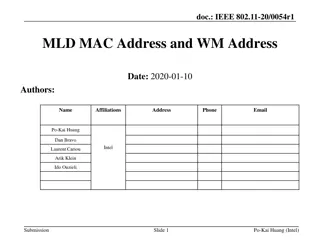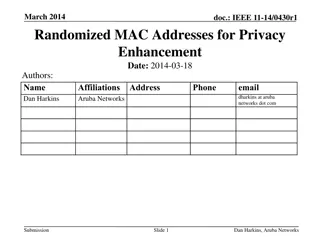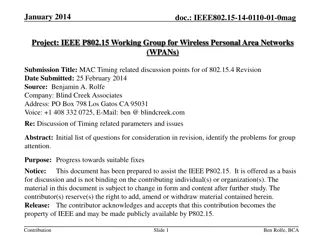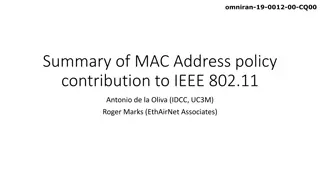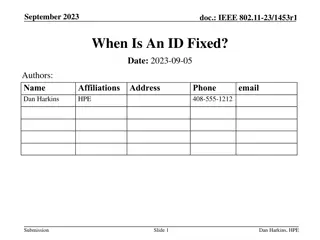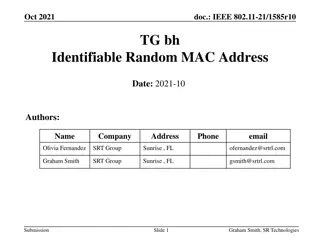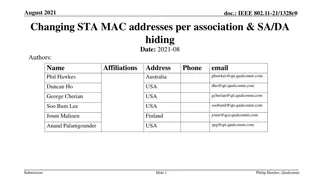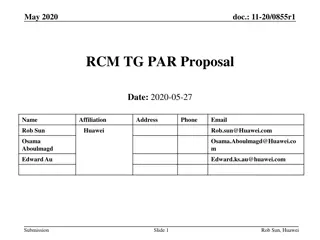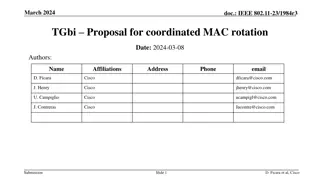Privacy Issues in IEEE 802.11 Networks: Tracking and MAC Randomization
This presentation delves into the privacy concerns surrounding 802.11 networks, focusing on tracking vulnerabilities and the limitations of MAC randomization in preventing tracking. It discusses the ease of tracking devices, the risk of passive tracking due to MAC addresses being visible in frames, and the rise of physical tracking systems using 802.11 identifiers. The presentation also explores the theory of MAC address randomization in WLAN, highlighting potential issues like identifier collision and disruption of services. Overall, it addresses the pressing need to enhance privacy measures in 802.11 networks.
Download Presentation

Please find below an Image/Link to download the presentation.
The content on the website is provided AS IS for your information and personal use only. It may not be sold, licensed, or shared on other websites without obtaining consent from the author. Download presentation by click this link. If you encounter any issues during the download, it is possible that the publisher has removed the file from their server.
E N D
Presentation Transcript
doc.: IEEE 11-16-1492-00-0wngg November 2016 Privacy Issues in 802.11 Networks Date: 2016-11-08 Authors: Name Affiliations Address Phone email Mathieu Cunche Univ. Lyon, INSA Lyon, Inria, CITI mathieu.cunche@insa-lyon.fr Juan Carlos Zuniga SIGFOX j.c.zuniga@ieee.org Mathy Vanhoef KU Leuven mathy.vanhoef@cs.kuleuven.be C lestin Matte Univ. Lyon, INSA Lyon, Inria, CITI celestin.matte@insa-lyon.fr Submission Slide 1 Mathieu Cunche, University of Lyon / Inria
doc.: IEEE 11-16-1492-00-0wngg November 2016 This presentation in a nutshell Tracking of 802.11 devices is easy There are growing market and population concerns about privacy issues with connected devices MAC randomization has been proposed to prevent tracking - but it is not enough ! Other information contained in frames can be used for tracking Submission Slide 2 Mathieu Cunche, University of Lyon / Inria
doc.: IEEE 11-16-1492-00-0wngg November 2016 802.11 and privacy Many individuals carry a 802.11 enabled device, e.g. smartphone 802.11 station are exposed to passive tracking Unique identifier: MAC address Available in clear-text in every frame Active service discovery Probe requests broadcast by unassociated stations Up to 3/min [1] Submission Slide 3 Mathieu Cunche, University of Lyon / Inria
doc.: IEEE 11-16-1492-00-0wngg November 2016 Physical tracking using 802.11 Rise of physical tracking systems based on 802.11 Set of monitoring nodes collecting identifiers Applications of physical tracking : Physical analytics (frequency and duration of visits) Road monitoring (travel time estimation) Surveillance Growing concern of civil society FTC Nomi (US)1, CNIL JCDecaux (France)2 Problem known since mid 2000's [2][3] but not addressed until now ... 1. https://www.ftc.gov/news-events/press-releases/2015/04/retail-tracking-firm-settles-ftc-charges-it-misled-consumers 2. http://marketinglaw.osborneclarke.com/advertising-regulation/jc-decauxs-pedestrian-tracking-system-blocked-by-french- data-regulator/ Submission Slide 4 Mathieu Cunche, University of Lyon / Inria
doc.: IEEE 11-16-1492-00-0wngg November 2016 MAC address Randomization (theory) MAC address Randomization in WLAN [3]: Periodically change the MAC address to a random value (pseudonym) Potential problems with random MAC MAC address is supposed to be globally unique Risk of identifier collision May disrupt other services/protocols OK for service discovery mode Collisions will have little impact No other services/protocols Possibly difficult for associated stations Collisions are rare but problematic Changing MAC address require to re-auth Might exhaust resources (DHCP) Submission Slide 5 Mathieu Cunche, University of Lyon / Inria
doc.: IEEE 11-16-1492-00-0wngg November 2016 MAC Address Randomization (practice) MAC address randomization adopted by the industry iOS1, Android2, Linux3, Windows 104 Random MAC only used in probe requests Except for Windows 10 Field experiments at IETF for associated mode [5] Ad-hoc implementation since no specification 1 B. Misra. iOS 8 MAC randomization analyzed! http://blog.airtightnetworks.com/ios8-mac- randomization-analyzed/ 2 Android 6.0 changes. Retrieved from https://developer.android.com/about/versions/ marshmallow/android-6.0-changes.html, 2015. 3 E. Grumbach. iwlwifi: mvm: support random MAC address for scanning. Linux commit effd05ac479b. 4 W. Wang. Wireless networking in Windows 10. In Windows Hardware Engineering ommunity conference (WinHEC), Mar. 2015. Submission Slide 6 Mathieu Cunche, University of Lyon / Inria
doc.: IEEE 11-16-1492-00-0wngg November 2016 Attacker model Capabilities : passive monitoring of 802.11 channels Active attacks are possible Objective: track individuals over time Group together frames with distinct MAC address pseudonym but belonging to the same device Using frame contents and timing Submission Slide 7 Mathieu Cunche, University of Lyon / Inria
doc.: IEEE 11-16-1492-00-0wngg November 2016 Other means to track 802.11 devices Content-based attacks Information Elements WPS UUID Predictable fields Sequence number Scrambler seed Active attacks Fake AP (Karma attack) Hotspot2.0 Timing attacks Submission Slide 8 Mathieu Cunche, University of Lyon / Inria
doc.: IEEE 11-16-1492-00-0wngg November 2016 Results from academic research Why MAC Address Randomization is Not Enough: An Analysis of Wi-Fi Network Discovery Mechanisms [5] How talkative is your mobile device?: an experimental study of Wi- Fi probe requests [1] The scrambler attack: A robust physical layer attack on location privacy in vehicular networks [9] Defeating MAC Address Randomization Through Timing Attacks Timing attacks [10] Submission Slide 9 Mathieu Cunche, University of Lyon / Inria
doc.: IEEE 11-16-1492-00-0wngg November 2016 Information Elements (IEs) Information Elements (Tags or Tagged parameters) Embedded in 802.11 frames Not mandatory Used to advertise support of functionalities Ex: Supported Rates, High Throughput capabilities Study of IE in the wild [5] Analysis of IE found in 3 datasets (160 000+ devices) IE based fingerprinting Large number of IE embedded in frames IEs with multiple parameters IEs provide enough entropy to uniquely identify a device within a large group 160 000 Submission Slide 10 Mathieu Cunche, University of Lyon / Inria
doc.: IEEE 11-16-1492-00-0wngg November 2016 Information Elements (IEs) HT Capabilities information element 160 000 Submission Slide 11 Mathieu Cunche, University of Lyon / Inria
doc.: IEEE 11-16-1492-00-0wngg November 2016 Information Elements (IEs) Identifying information provided by IE in considered datasets 160 000 Submission Slide 12 Mathieu Cunche, University of Lyon / Inria
doc.: IEEE 11-16-1492-00-0wngg November 2016 Information Elements : WPS UUID WPS Information Element WPS (Wi-Fi Protected Setup) protocol simplifies device pairing WPS compatible devices can include a WPS IE WPS IE includes a UUID field Tracking threat of WPS UUID [5] UUID is by definition a unique identifier: can be used for tracking UUID is computed by hashing the MAC address [6] Can be reversed back to the real MAC address Brute-force attack led to successful reversing in 92% of cases Submission Slide 13 Mathieu Cunche, University of Lyon / Inria
doc.: IEEE 11-16-1492-00-0wngg November 2016 Predictable fields Predictable field : non constant field whose value can be predicted from the previous frames Example : sequence number field Frame counter included in 802.11 header Predictable : simple increment Sequence number field in iOS random MAC Counter not reset upon MAC address change [1] Can be used to defeat MAC randomization Source: J. Freudiger Submission Slide 14 Mathieu Cunche, University of Lyon / Inria
doc.: IEEE 11-16-1492-00-0wngg November 2016 Predictable fields: scrambler seed 802.11 PHY Scrambler seed [7] Embedded in OFDM frames Seed used to initialize PRNG generating the scrambling sequence No specification on how to generate the seed sequence the initial state of the scrambler shall be set to a pseudorandom nonzero state (18.3.5.5) Submission Slide 15 Mathieu Cunche, University of Lyon / Inria
doc.: IEEE 11-16-1492-00-0wngg November 2016 Predictable fields: scrambler seed (cont d) Collecting scrambler seeds Part of the PHY layer: not available at the MAC layer Standard hardware not helpful here Solution: use Software Defined Radio Implementation of 802.11 based on Gnuradio + USRP + Faraday Room Inria FIT CortexLab Submission Slide 16 Mathieu Cunche, University of Lyon / Inria
doc.: IEEE 11-16-1492-00-0wngg November 2016 Predictable fields: scrambler seed (cont'd) The scrambler seed : a predictable field Observed patterns in real world implementations [9][5] Freewheeling : state of the LFSR at the end of a frame is reused for the next frame Constant seed (or limited to a small set) Incremental: seed value is incremented by one at each frame Scrambler seeds can be used to track 802.11 transmitters Submission Slide 17 Mathieu Cunche, University of Lyon / Inria
doc.: IEEE 11-16-1492-00-0wngg November 2016 Active attacks Karma attack [5] Stations switch back when their real MAC address when attempting to associate with the AP Attack : Create a fake AP with popular SSID Collect real MAC address of STA attempting to associate Hotspot 2.0 based attack [5] HS2.0 (802.11u)[8]: protocol allowing roaming STA sends ANQP queries to AP to retrieve list of available services STA switches back to their real MAC address when querying Query also contains predictable counter that might help tracking Attack : create AP advertising HS2.0 capabilities Collect real MAC address of querying STAs Submission Slide 18 Mathieu Cunche, University of Lyon / Inria
doc.: IEEE 11-16-1492-00-0wngg November 2016 Timing attacks Timing in active service discovery Probe sent at regular interval Timing features of probe requests Interval between probe requests within a burst Interval between bursts Observed timing of probe requests can be used for tracking [10] Channel order could also be exploited [11] Submission Slide 19 Mathieu Cunche, University of Lyon / Inria
doc.: IEEE 11-16-1492-00-0wngg November 2016 Summary MAC randomization is a good protection against privacy issues but can currently be defeated by advanced attacks Presented list of attacks is not exhaustive Other privacy issues in 802.11 specifications Identifying implementation-specific usage of multiple optional parameters in frames Identifying implementation-specific generation of (pseudo-)random parameters Correlating state changes of different parameters between themselves, and/or with incremental counters Too much freedom in specification can lead to implementation fingerprinting, which opens up privacy and security issues Submission Slide 20 Mathieu Cunche, University of Lyon / Inria
doc.: IEEE 11-16-1492-00-0wngg November 2016 Further thoughts How often should identifiers be changed (frequency)? Should we provide recommendation on how to generate (pseudo-)random parameters? e.g. MAC address, scrambler seeds, Unlinkability of consecutive values Submission Slide 21 Mathieu Cunche, University of Lyon / Inria
doc.: IEEE 11-16-1492-00-0wngg November 2016 Straw Poll Do you think 802.11 specifications should include privacy recommendations about the usage of its protocols and parameters? Y: N: A: Submission Slide 22 Mathieu Cunche, University of Lyon / Inria
doc.: IEEE 11-16-1492-00-0wngg November 2016 References [1]J. Freudiger, How talkative is your mobile device?: an experimental study of Wi-Fi probe requests, in Proceedings of the 8th ACM Conference on Security & Privacy in Wireless and Mobile Networks, 2015, p. 8. [2]J. Pang, B. Greenstein, R. Gummadi, S. Seshan, and D. Wetherall, 802.11 User Fingerprinting, in Proceedings of the 13th Annual ACM International Conference on Mobile Computing and Networking, New York, NY, USA, 2007, pp. 99 110. [3]M. Gruteser and D. Grunwald, Enhancing location privacy in wireless LAN through disposable interface identifiers: a quantitative analysis, Mobile Networks and Applications, vol. 10, no. 3, pp. 315 325, 2005. [4] C. J. Bernardos, J. C. Z iga, and P. O Hanlon, Wi-Fi internet connectivity and privacy: Hiding your tracks on the wireless Internet, in 2015 IEEE Conference on Standards for Communications and Networking (CSCN), 2015, pp. 193 198. Submission Slide 23 Mathieu Cunche, University of Lyon / Inria
doc.: IEEE 11-16-1492-00-0wngg November 2016 References [5]M. Vanhoef, C. Matte, M. Cunche, L. S. Cardoso, and F. Piessens, Why MAC Address Randomization is Not Enough: An Analysis of Wi-Fi Network Discovery Mechanisms, in Proceedings of the 11th ACM on Asia Conference on Computer and Communications Security, New York, NY, USA, 2016, pp. 413 424. [6]P. Leach, M. Mealling, and R. Salz. A universally unique identifier (UUID) URN namespace. RFC 4122 (Proposed Standard), July 2005. [7]IEEE Std 802.11-2012. Wireless LAN Medium Access Control (MAC) and Physical Layer (PHY) Specifications, 2012. [8] IEEE Std 802.11u. Wireless LAN Medium Access Control (MAC) and Physical Layer (PHY) Specifications: Amendment 9: Interworking with External Networks, 2011. Submission Slide 24 Mathieu Cunche, University of Lyon / Inria
doc.: IEEE 11-16-1492-00-0wngg November 2016 References [9]B. Bloessl, C. Sommer, F. Dressier, and D. Eckhoff, The scrambler attack: A robust physical layer attack on location privacy in vehicular networks, in 2015 International Conference on Computing, Networking and Communications (ICNC), 2015, pp. 395 400. [10]C. Matte, M. Cunche, F. Rousseau, and M. Vanhoef, Defeating MAC Address Randomization Through Timing Attacks, in Proceedings of the 9th ACM Conference on Security & Privacy in Wireless and Mobile Networks, New York, NY, USA, 2016, pp. 15 20. [11]O. Waltari and J. Kangasharju, The Wireless Shark: Identifying WiFi Devices Based on Probe Fingerprints, in Proceedings of the First Workshop on Mobile Data, New York, NY, USA, 2016, pp. 1 6. Submission Slide 25 Mathieu Cunche, University of Lyon / Inria
doc.: IEEE 11-16-1492-00-0wngg November 2016 Backup Submission Slide 26 Mathieu Cunche, University of Lyon / Inria
doc.: IEEE 11-16-1492-00-0wngg November 2016 Datasets Datasets of probe requests Submission Slide 27 Mathieu Cunche, University of Lyon / Inria




